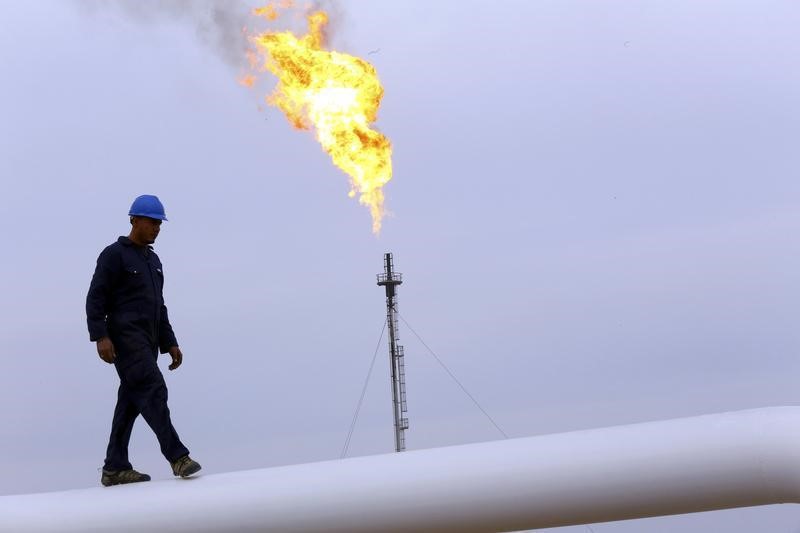Oil hits 6-week low on China demand worries; crude in ‘contango’ mode
2022.11.18 12:32
[ad_1]

© Reuters.
By Barani Krishnan
Investing.com – Crude prices entered into “contango” mode — a market structure that defines weakness — the first time since 2021 after carrying potential weekly losses of as much as 10% as China’s Covid headlines, new hawkish signals from the Federal Reserve, and easing supply worries all came to a head for oil bulls.
The front-month December contract for the U.S. crude benchmark , or WTI, was at $79.42 a barrel by 11:15 ET (16:15 GMT), down $2.22, or 2.7%. Earlier, December WTI traded at a discount to the January 2023 contract.
While the so-called contango difference between the contracts was meager, it represented a structural oil market weakness where buyers wishing to hold a position in WTI at the time of contract expiry would pay more to switch to a new front-month contract.
WTI aside, the front-month January contract in , the global oil benchmark, was at $87.31 a barrel, down $2.47, or 2.8%. Like WTI, January Brent was also at a contango to February Brent earlier.
On a weekly basis, WTI was down 10.8% at the time of writing, adding to last week’s near 4% deficit. Brent was off 9% for the current week, after last week’s slide of 2.6%.
In terms of contract lows, WTI’s session bottom of $77.23 and Brent’s intraday low of $85.81 both marked a trough since Sept. 28.
“Oil prices are continuing to retreat against the backdrop of increasingly gloomy economic prospects and surging Covid cases in China which risk further restrictions and lockdowns, threatening demand in the world’s second-largest economy,” said Craig Erlam, analyst at online trading platform OANDA.
With Brent having broke below the psychological $90 mark and WTI at under $80, Erlam wondered much this would test the “patience of OPEC+” — the global oil producing alliance that decided from this month to cut 2 million barrels per day from the collective output of the 23 countries in its coalition.
Erlam noted that OPEC+ was severely criticized for the production cut by the Biden administration and the Paris-based International Energy Agency, which represents oil consuming countries — and yet the alliance’s efforts came to nothing in terms of price support.
OPEC+’s motive was to offset constant worries about oil demand that had crept up in recent months as global economies sent off recession signals from runaway inflation in the aftermath of the pandemic. Crude prices hit 14-year highs in March, with Brent just shy of $140 and WTI tipping just over $130. By September though, Brent had fallen to around $82 and WTI to around $76.
The OPEC+ ordered production cuts sent Brent up again almost $100 two weeks ago and WTI reached above $93.
But Covid headlines out of China zapped the rebound, driving both benchmarks forcefully lower over the past fortnight.
St. Louis Federal Reserve President James Bullard — one of the U.S. central bank’s biggest policy hawks — has added to the bearish pressure on oil by saying that inflation remains “unacceptably high” for the Fed to ditch jumbo-sized rate hikes in favor of only smaller increases.
Some of the geopolitical risk that sent oil higher earlier this year, specifically the Ukraine conflict, had also eased of late. For instance, Poland and NATO concluded on Wednesday that a missile that crashed inside Poland was probably a stray fired by Ukraine’s air defenses and not a Russian strike, easing fears that the conflict between Russia and Ukraine was spilling across the border.
With all the negativity in the market, “could OPEC+ go even further [with production cuts] if the outlook continues to deteriorate when it meets again in a couple of weeks?” Erlam asked in the oil market commentary he issued Friday.
OPEC+ meets on Dec. 4 to review its production policy — just before the start of the Dec. 5 “price cap” on Russian oil, which is widely expected to be a market boosting event for crude, given that the EU-G7 engineered initiative will theoretically lead to reprisals from Moscow.
Some analysts, however, think Saudi Arabia — which leads OPEC+ as the Arab world’s largest oil producer and as the only nation with the perceived ability to hike and cut crude exports at will — might not be able to go too far from November’s two million-barrels per day cut.
“Not so sure KSA has much of a hand to play,” Art Berman, an energy analyst widely-followed on Twitter, said, referring to the Kingdom of Saudi Arabia, which he added would probably be “more effective at flooding the market than starving it in the past” and was also “super-aware of maintaining its role as an honest & reliable supplier unlike Russia”.
In another tweet labeled “Aramco Theater”, Berman played down state-owned Saudi oil company Aramco’s caution that world oil capacity remained at ‘extremely low’ levels — the company’s reminder to the oil trade that crude prices should be correspondingly higher.
“The world should be worried’: Saudi Aramco…has issued a dire warning over ‘extremely low’ capacity,” Berman wrote. “It has been “extremely low” for the last decade except for the 2 years of COVID.”
Talk is also growing that the G7-EU engineered Russian oil price cap, which market bulls expect to lead to an even bigger crunch in global supply, will only result in a fleeting price rally.
“That’s because Russian barrels will likely get rerouted and not taken off the market,” said John Kilduff, founding partner at New York energy hedge fund Again Capital. “That’s exactly the wish of the U.S. and its allies — that the Russians earn considerably less for the same volume of oil floating around the market.”
[ad_2]
Source link








